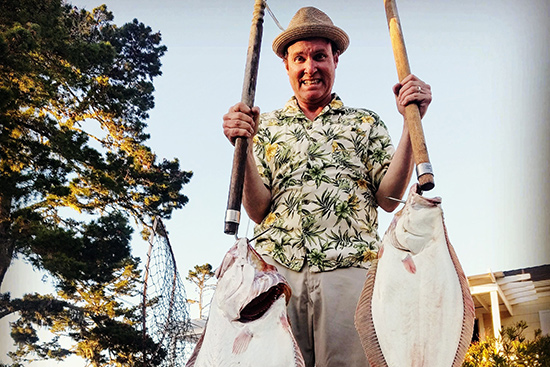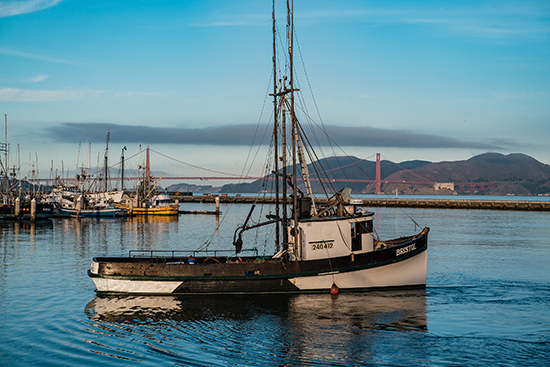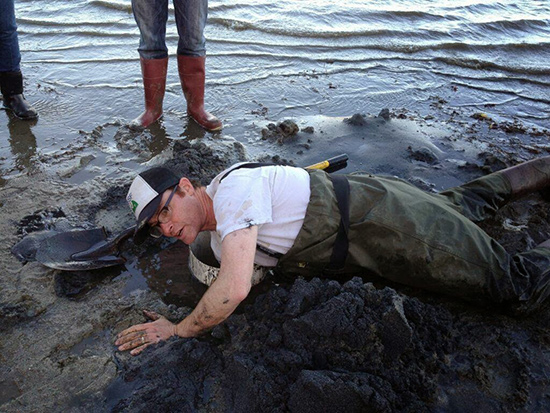氣候變化重創加州餐飲行業,可持續的海鮮在哪里?

|
“加州已經不正常了。”位于舊金山海邊的海鮮餐館和批發商Two X Sea的老板肯尼·貝洛夫說。他說的不是加州山火蔓延,還有房價高企,當然也都是事實。他說的是加州魚類的問題。“現在人們往水里拋竿,但無法保證能釣上來東西。” 說起從太平洋打撈的海鮮,人們熟悉的可能不可持續。可持續的品種又不太受大眾歡迎。還好加州有一群意志堅定的漁民、供應商和食客,情況或許有所改變。只是可能沒有那么快。 受人類活動影響,加州海岸外的水逐漸變暖。去年8月,圣迭戈的海面溫度達到歷史新高。美國環境保護署稱,自20世紀初以來,加州太平洋沿岸海平面平均溫度上升了1到1.5華氏度。 氣候變化令餐飲行業受到重創,最新數據顯示,2017年該行業收入達1.96億美元。2015年,喜好溫暖水域的有毒海藻爆發,導致當年鄧杰尼斯蟹季的大部份時間里無蟹可吃。氣候變化可能導致加州和太平洋西北部的鮭魚種群中度甚至重度減少。多刺龍蝦之類的物種棲息地向北方移動。 |
“There is no more normal in California,” says Kenny Belov, the owner of Two X Sea, a seafood restaurant and wholesaler on San Francisco’s waterfront. He’s not talking about the state’s wildfires or housing prices—although he certainly could be. Instead he means California fish: “People will drop their gear in the water, but there is no guarantee that they will bring something up.” When it comes to seafood harvested from the Pacific Ocean, what’s familiar may not be sustainable. And what’s sustainable may not have mass appeal. But thanks to a determined group of fishermen, purveyors, and foragers in California, that may be changing. It just may not be changing fast enough. Thanks to human activity, the water off of California’s coast is warming. Last August, the surface of the sea surface off San Diego reached the highest temperature ever recorded. According to the United States Environmental Protection Agency, average sea surface temperatures on California’s Pacific coast rose a degree to a degree and a half Fahrenheit since the beginning of the 20th century. Climate change has already pummeled an industry that reached $196 million in revenue in 2017, the most recent year for which data is available. In 2015, an outbreak of toxic algae that may thrive in warming waters triggered the closure of most of the year’s Dungeness crab season. Climate change is expected to cause moderate to severe declines in salmon populations across California and the Pacific Northwest. And the habitat of species like the spiny lobster has been pushed northward. |

|
當然,并不是每個指標都很負面。今年3月,加州大學圣巴巴拉分校的博士后克里斯托弗·弗里作為主要作者,在《科學》雜志上發表了一篇評估氣候變化對漁業影響的論文。盡管從1930年到2010年全球最大可持續產量下降了4.1%,但下降幅度并不均勻。在加州洋流中,太平洋洋流沿著北美西海岸向南移動,弗里告訴我:“魚類數量受氣候變暖的影響并不嚴重。可能是因為管理得力。”對于弗里與論文其他作者分析的每個物種,包括沙丁魚、羚羊和石魚來說,估計加州變暖的效果在統計上幾乎為零。 但過去沒問題并不保證未來也一樣。對貝洛夫來說,問題說起來容易,解決起來卻很難,“我們熱愛的美食是不該吃的東西。” 以后吃什么 “太令人沮喪了。美國人吃什么?北美消費排名第一的海鮮是蝦。”貝洛夫的朋友,也是Sea Forager的創始人柯克·隆巴德補充道,Sea Forager提供海濱徒步旅行服務,也出售可持續的海鮮。 對隆巴德來說,最可持續的海鮮都在食物鏈底部。“體現出小魚的好處。”他說。不過,意識到野生鮭魚或藍鰭金槍魚不太可持續是一回事,說服消費者選擇并不熟悉的海鮮代替則是另一回事,比如可以改吃紫海膽,比起人們更常食用的海膽,紫海膽的魚卵數量不一樣,或者可以選擇多刺龍蝦,只是少了美國食客熱愛的大鉗子。 |
To be sure, not every indicator is negative. In March, Christopher Free, a postdoctral scholar at the University of California, Santa Barbara was the lead author on a paper in Science that estimated the effect of climate change on fisheries. Although the global maximum sustainable yield dropped 4.1% from 1930 to 2010, the decrease was not evenly distributed. In the California Current, a Pacific Ocean current moving southward along the western coast of North America, Free tells me, “fish populations haven’t been strongly impacted by warming. It’s probably the result of good management.” For each of the species that Free and his coauthors analyzed—which included sardine, lingcod, and rockfish—the estimated effect of warming in California was statistically indistinguishable from zero. But past successes do not guarantee future ones. For Belov, the problem is easy to state and hard to solve: “The things we want are the things we shouldn’t be eating.” What to Eat Next “It’s depressing. What do Americans eat? The number one seafood consumed in North America is shrimp,” adds Kirk Lombard, a friend of Belov and the founder of Sea Forager, which gives coastal walking tours and sells sustainable seafood. For Lombard, the most sustainable seafood to eat live at the bottom of the food chain: ”The gospel of small fishes,” he says. It’s one thing to realize that wild salmon or bluefin tuna isn’t the most sustainable option. It’s quite another to convince consumer to substitute them with unfamiliar seafood like purple urchins, which tend not have the same amount of roe as their more commonly eaten cousins, or spiny lobsters, which lack the big claws that American eaters prize. |

|
隆巴德改變了很多人對鯡魚等海鮮的看法,鯡魚在舊金山海灣很多,但消費量比不上阿姆斯特丹等地,荷蘭人把鯡魚當熱狗一樣當零食吃。但跟法律允許的大麻不同,此類創新在美國并未流行。2017年,也是有完整數據的最近一年,加州商業捕撈僅包括價值196美元的鯡魚,全都在洛杉磯,舊金山收獲了價值14884美元的鯡魚魚卵。與加州主要漁業相比,這些數字只能算零頭。相比之下,魷魚總收入為6800萬美元,鄧杰尼斯蟹4700萬美元,奇努克鮭魚480萬美元,劍魚390萬美元,大眼金槍魚350萬美元。 太平洋各州海洋漁業委員會的高級項目經理戴夫·科爾珀說,換言之,加州的海產品也可能分布在不同的海里。一方面,工業規模的拖網漁船捕撈牙鱈和綠鱈之類,運往冷藏室制作快餐三明治。“那些船的捕魚量簡直難以想象。”另一種則是中型船,捕捉鄧杰尼斯蟹和鮭魚,此外還有小型漁船捕捉其他海產。“海膽可不像魚當中的麥當勞。”他笑著說。 下一個爆款是海藻? 如果說海膽是精品,那海草算什么?對凱瑟琳·奧哈拉來說,海藻就是下一個爆款。2017年,她和另外兩位女性聯合創立了建立了Salt Point Seaweed,從門多西諾海岸打撈野生海藻賣給餐廳,也直接向消費者出售。她們收獲的海藻包括kombu、wakeme和nori,奧哈拉認為這幾種都通過了嚴格的測試:“這些海藻在主流文化中已經存在了很長時間,沒有上學的兒童都喜歡。” 數字可證明。加州魚類和野生動物部最近的數據為2015年,顯示商業可食用藻類產量達27公噸。當1997年加州開始統計相關數據時,數量還不足5公噸。 除了野生海藻,奧哈拉也在探索人工養殖海藻。今年,她跟托馬斯灣霍格島的牡蠣公司完成了試點項目,主要種植流行美食沖浪碗里常見的紅藻,也養殖牡蠣。 結果表明,同時養殖紅藻和牡蠣好處很明顯。氣候變化對貝類的一大威脅是海洋酸化,即從大氣進入水中的二氧化碳導致酸堿值下降。海水變酸會影響貝殼生存,牡蠣幼蟲發育之前便會死亡。 現在有了海藻。“跟地球上大多數植物一樣,海藻從空氣中吸收碳和氮。”奧哈拉說。“現在水中的碳酸太多了。”去年,試驗區里的海藻從水中吸收了部分碳,降低了對牡蠣的傷害。 這里提供了未來從太平洋捕撈海鮮的另一種模式。現在問題只剩下消費者是不是能夠跟上轉變腳步了。(財富中文網) 譯者:馮豐 審校:夏林 |
Lombard proselytizes fishes like herring, which are plentiful in the San Francisco Bay, but not consumed here as they are in cities like Amsterdam, where the Dutch snack on them like hot dogs. But unlike legally-tolerated marijuana, that innovation has failed to catch on in the United States. In 2017, the most recent year for which complete data is available, just $196 worth of herring was caught commercially in California—all of it in Los Angeles—while $14,884 worth of herring roe was harvested in San Francisco. Those are rounding errors compared to the state’s major fish industries. By contrast, market squid landings totaled $68 million in revenue, Dungeness crab $47 million, Chinook salmon $4.8 million, swordfish revenue totaled $3.9 million, and bigeye tuna $3.5 million. California’s seafood, in other words, might as well swim in two different oceans, says Dave Colpo, senior program manager at the Pacific States Marine Fisheries Commission. On the one side, there are industrial-scale trawlers that catch things like whiting and pollack destined for the freezer aisle and fast food sandwiches. “You can’t imagine how much gets pumped off those boats.” On the other are the mid-scale boats that fish for Dungeness crab and salmon, as well as the smaller outfits that catch everything else. “Urchin is not the McDonald’s of fish,” he says with a laugh. Is Seaweed the Next Big Thing? And if urchin is boutique, what does that make seaweed? For Catherine O’Hara, it’s the next big thing. In 2017, she and two other women founded Salt Point Seaweed, harvesting wild seaweed from the Mendocino Coast and selling it to restaurants and directly to consumers. They gather kombu, wakame, and nori—seaweeds that O’Hara thinks pass a tough test: “They’ve been around for long enough in mainstream culture that preschoolers are hooked on them.” The numbers bear her out. In 2015, the most recent year for which the California Department of Fish and Wildlife has data available, the commercial edible algae harvest reached 27 metric tons. In 1997, when the state began keeping that data, the amount was less than five metric tons. In addition to wild harvesting, O’Hara is exploring farmed seaweed. This year, she completed a pilot project with Hog Island Oyster Co. in Tomales Bay, in which she grew red algae similar to that served in poke bowls, alongside the cultivated oysters. Turns out that farming the two species together can bring significant benefits. One of the big threats to shellfish from climate change is ocean acidification, the decrease in pH caused by the uptake of carbon dioxide from the atmosphere into the water. When the water turns too acidic, it can eat away shells, killing oyster larvae before they develop. Enter the seaweed. “Just like most plants on earth take out of the air, seaweed takes carbon and nitrogen out of the water,” says O’Hara. “In the water right now, there’s too much carbonic acid.” Over the last year, their experimental plot of seaweed pulled some of that carbon out of the water, lessening the damage to the oysters. It’s an alternative model of how seafood might be harvested from the Pacific Ocean in the future. Now all that remains is to see whether consumers will catch up. |













